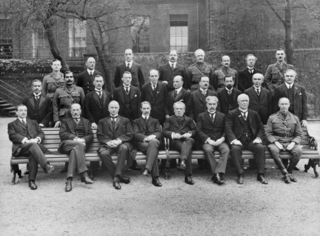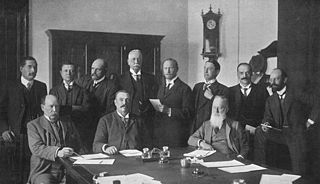
Imperial Conferences were periodic gatherings of government leaders from the self-governing colonies and dominions of the British Empire between 1887 and 1937, before the establishment of regular Meetings of Commonwealth Prime Ministers in 1944. They were held in 1887, 1894, 1897, 1902, 1907, 1911, 1921, 1923, 1926, 1930, 1932 and 1937.

Joseph Chamberlain was a British statesman who was first a radical Liberal, then a Liberal Unionist after opposing home rule for Ireland, and eventually served as a leading imperialist in coalition with the Conservatives. He split both major British parties in the course of his career. He was the father, by different marriages, of Nobel Peace Prize winner Austen Chamberlain and of Prime Minister Neville Chamberlain.
In the British Empire, a self-governing colony was a colony with an elected government in which elected rulers were able to make most decisions without referring to the colonial power with nominal control of the colony. This was in contrast to a Crown colony, in which the British Government ruled and legislated via an appointed Governor, with or without the assistance of an appointed Council. Most self-governing colonies had responsible government.

The Imperial War Cabinet (IWC) was the British Empire's wartime coordinating body. It met over three sessions, the first from 20 March to 2 May 1917, the second from 11 June to late July 1918, and the third from 20 or 25 November 1918 to early January 1919. Consisting of representatives from Canada, Australia, India, the Dominion of Newfoundland, New Zealand, South Africa and the United Kingdom, the Cabinet considered many aspects of waging the First World War. It led to the United Kingdom's Dominions being considered more equal to Great Britain. Held concurrently with the cabinet were the Imperial War Conferences of 1917 and 1918.
A Crown colony or royal colony was a colony administered by the Crown within the British Empire. There was usually a governor, appointed by the British monarch on the advice of the UK Government, with or without the assistance of a local council. In some cases, this council was split into two: an executive council and a legislative council, and was similar to the Privy Council that advises the monarch. Members of executive councils were appointed by the governors, and British citizens resident in Crown colonies either had no representation in local government, or limited representation. In several Crown colonies, this limited representation grew over time. As the House of Commons of the British Parliament has never included seats for any of the colonies, there was no direct representation in the sovereign government for British subjects or citizens residing in Crown colonies.

The Imperial Federation was a series of proposals in the late 19th and early 20th centuries to create a federal union to replace the existing British Empire, presenting it as an alternative to colonial imperialism. No such proposal was ever adopted, but various schemes were popular in Australia, Canada, New Zealand, and other colonial territories. The project was championed by Unionists such as Joseph Chamberlain as an alternative to William Gladstone's proposals for home rule in Ireland.

The Federation of Australia was the process by which the six separate British self-governing colonies of Queensland, New South Wales, Victoria, Tasmania, South Australia, and Western Australia agreed to unite and form the Commonwealth of Australia, establishing a system of federalism in Australia. The colonies of Fiji and New Zealand were originally part of this process, but they decided not to join the federation. Following federation, the six colonies that united to form the Commonwealth of Australia as states kept the systems of government that they had developed as separate colonies, but they also agreed to have a federal government that was responsible for matters concerning the whole nation. When the Constitution of Australia came into force, on 1 January 1901, the colonies collectively became states of the Commonwealth of Australia.

The Colony of New South Wales was a colony of the British Empire from 1788 to 1901, when it became a State of the Commonwealth of Australia. At its greatest extent, the colony of New South Wales included the present-day Australian states of New South Wales, Queensland, Victoria, Tasmania, and South Australia, the Northern Territory as well as New Zealand. The first "responsible" self-government of New South Wales was formed on 6 June 1856 with Sir Stuart Alexander Donaldson appointed by Governor Sir William Denison as its first Colonial Secretary.

The Federal Council of Australasia was a forerunner to the current Commonwealth of Australia, though its structure and members were different.

The territorial evolution of the British Empire is considered to have begun with the foundation of the English colonial empire in the late 16th century. Since then, many territories around the world have been under the control of the United Kingdom or its predecessor states. When the Kingdom of Great Britain was formed in 1707 by the union of the Kingdoms of Scotland and England, the latter country's colonial possessions passed to the new state. Similarly, when Great Britain was united with the Kingdom of Ireland in 1801 to form the United Kingdom, control over its colonial possessions passed to the latter state. Collectively, these territories are referred to as the British Empire. When much of Ireland gained independence in 1922 as the Irish Free State, the other territories of the empire remained under the control of the United Kingdom.

The 1887 Colonial Conference met in London in 1887 on the occasion of Queen Victoria's Golden Jubilee. It was organised at the behest of the Imperial Federation League in hopes of creating closer ties between the colonies and the United Kingdom. It was attended by more than 100 delegates, mostly unofficial observers, from both self-governing and dependent colonies. India, however, was not represented.

Sir John Anderson was a Scottish colonial administrator who served as Governor of Ceylon between 1916 and 1918, and Governor of the Straits Settlements between 1904 and 1911.
Australia is a constitutional monarchy whose Sovereign also serves as Monarch of the United Kingdom, New Zealand, Canada and eleven other former dependencies of the United Kingdom including Papua New Guinea, which was formerly a dependency of Australia. These countries operate as independent nations, and are known as Commonwealth realms. The history of the Australian monarchy has involved a shifting relationship with both the monarch and also the British government.
The 1894 Colonial Conference was called by the government of Canada to continue discussion begun at the 1887 Colonial Conference on a proposal to lay a telegraph cable at the bottom of the Pacific Ocean to create a communications link between Canada and Australasia and, by extension, to the rest of the British Empire as part of what became referred to as the All Red Line network of cables throughout the Empire.

The 1902 Colonial Conference followed the conclusion of the Boer War and was held on the occasion of the coronation of King Edward VII. As with the previous conference, it was called by Secretary of State for the Colonies Joseph Chamberlain who opened it on 30 June 1902.
A Dominion was any of several self-governing nations of the British Empire. With the evolution of the British Empire into the Commonwealth of Nations, the dominions became independent states.
A series of referendums on the proposed constitution of Australia were held between 2 June 1898 and 31 July 1900 in the six colonies that were to become the states of the Commonwealth of Australia. The first four referendums were held in New South Wales, South Australia, Tasmania and Victoria in June 1898. Although all four saw a majority vote in favour, the majority in New South Wales was insufficient. Knowledge of the result in New South Wales led to low voter turnout in South Australia.
The 1907 Imperial Conference was convened in London on 15 April 1907 and concluded on 14 May 1907. During the sessions a resolution was passed renaming this and future meetings Imperial Conferences. The chairman of the conference was British prime minister Sir Henry Campbell-Bannerman.
Francis Peter Labilliere was an Anglo-Australian historian.

The National Convention, also known as the Convention on the Closer Union of South Africa or the Closer Union Convention, was a constitutional convention held between 1908 and 1909 in Durban, Cape Town and Bloemfontein. The convention led to the adoption of the South Africa Act by the British Parliament and thus to the creation of the Union of South Africa. The four colonies of the area that would become South Africa - the Cape Colony, Natal Colony, the Orange River Colony and the Transvaal Colony - were represented at the convention, along with a delegation from Rhodesia. There were 33 delegates in total, with the Cape being represented by 12, the Transvaal eight, the Orange River five, Natal five, and Rhodesia three. The convention was held behind closed doors, in the fear that a public affair would lead delegates to refuse compromising on contentious areas of disagreement. All the delegates were white men, a third of them were farmers, ten were lawyers, and some were academics. Two-thirds had fought on either side of the Second Boer War.











